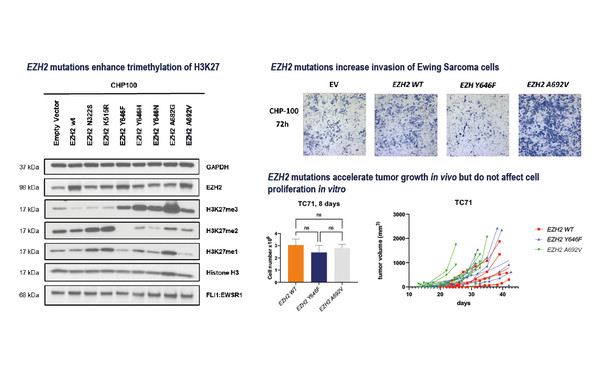Activating EZH2 mutations may define a new subset of aggressive Ewing sarcomas that benefit from treatment with an EZH2 inhibitor
Results presented at the ESMO Sarcoma and Rare Cancers Congress 2023 (Lugano, 20–22 March) highlight the value of characterising the molecular landscape of rare tumours for potential therapeutic gain. Researchers identified activating EZH2 mutations in around 4% of the Ewing sarcomas tested and while these sarcomas were associated with invasive features, treatment with the EZH2 inhibitor, tazemetostat, appeared to reverse the aggressive phenotype in preclinical models (Abstract 47MO).
In this study, activating EZH2 mutations were found in 6 out of 200 patients with Ewing sarcoma from the Memorial Sloan Kettering Cancer Center, New York, who were prospectively tested with the MSK-IMPACT large-panel next-generation sequencing assay, and in 2 out of 22 patients from Warsaw’s Maria Sklodowska-Curie National Research Institute of Oncology who were tested with the Oncomine Comprehensive assay. Over a median follow-up of 55 months, 6 of the 8 patients with EZH2 mutations developed distant metastases and 5 died.
In preclinical studies, EZH2-mutated cell lines versus wild-type cells showed enhanced H3K27 trimethylation and transcriptional repression, including immune response-related genes. Cancer testis antigens (CTAs) MAGE-C1, MAGE-C2 and TEX-19 were among the most upregulated genes. EZH2-mutated cell lines also showed increased invasion and accelerated tumour growth in vivo.
Importantly, tazemetostat was able to decrease H3K27 trimethylation and inhibit cell invasion. While EZH2 mutations decreased sensitivity to doxorubicin, this sensitivity was restored with tazemetostat. As another potential therapeutic approach, the authors also concluded that overexpression of CTAs may make EZH2-mutant Ewing sarcoma a candidate for immunotherapy.
Prof. Jean-Yves Blay from the Léon Bérard Center, Lyon, France welcomes analyses such as these and comments: “This study shows that a subset of patients with Ewing sarcoma with worse prognosis have a potential molecular vulnerability. The exploitation of this observation for therapeutic application, using EZH2 inhibitors, should be investigated.”
Abstract discussed:
Sobczuk P, et al. Activating EZH2 mutations define a new subset of aggressive Ewing sarcomas. ESMO Sarcoma and Rare Cancers Congress 2023, Abstract 47MO
Mini Oral Session, 22.03.2023, h. 09:00 – 10:00, Hall B3







